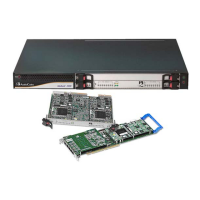SIP User's Manual 18 Document #: LTRT-68806
Mediant 2000 & TP-1610 & TP-260/UNI
1.4 TP-260 Overview
The TP-260 is a complete SIP-compliant, VoIP media processing server and VoIP
gateway. The SIP-compliant "gateway on a blade’, delivers a cost-effective solution in a
convenient PCI form-factor. This unique stand-alone PCI gateway operates independently
and only relies on the host PCI for its power. The TP-260 communicates to applications via
SIP using an on-board Ethernet interface. Using a special standards-based approach
eliminates host PC device drivers and operation system dependencies, seamlessly
connecting existing PSTN-based systems to support VoIP.
The TP-260 is an ideal solution for SIP trunking gateways and integrated gateways for IP-
PBXs and all-in-one communication servers. The blade is designed for enterprise
applications or for smaller to medium PC-based systems. The TP-260 provides up to 240
simultaneous ports for voice, fax or data for VoIP gateway applications providing excellent
voice quality and optimized packet voice streaming over IP networks. Employing SIP as a
control protocol, the TP-260 enables System Integrators short time-to-market and reliable
cost-effective deployment of next-generation networks. The TP-260 utilizes the TPM-1100
PMC module, which is based on the VolPerfect™ architecture, AudioCodes' underlying
core media gateway technology.
The TP-260 matches the density requirements for small to medium locations, while
meeting NSP’s demands for scalability. The TP-260 stand-alone VoIP gateway on a blade,
scales from 1 to 8 E1/T1/J1 spans (1, 2, 4, or 8 spans) in a single PCI slot and provides an
excellent gateway solution for enterprise applications as well as carrier locations.
The TP-260 supports various ISDN PRI protocols such as EuroISDN, North American NI2,
Lucent™ 4/5ESS, Nortel™ DMS100 and others. In addition, it supports different variants of
CAS protocols for E1 and T1 spans, including MFC R2, E&M immediate start, E&M delay
dial / start, loop start and ground start.
The deployment architecture can include several TP-260 gateways in branch or
departmental offices; connected to local PBXs. Call routing is performed by the gateways
using internal routing or SIP Proxy(s). The TP-260 enables users to make cost-effective,
long distance or international telephone/fax calls between distributed company offices,
using their existing telephones/fax. These calls can be routed over the existing network
using state-of-the-art compression techniques, ensuring that voice traffic uses minimum
bandwidth.
The TP-260 enables the deployment of ‘Voice over Packet’ solutions in environments
where access is enabled to PSTN subscribers by using a trunking gateway. This provides
the ability to transmit voice and telephony signals between a packet network and a TDM
network. Routing of the calls from the PSTN to a SIP service node (e.g., Call Center) is
performed by the TP-260 internal routing feature or by a SIP Proxy.
Enabling accelerated design cycles with higher density and reduced costs, the TP-260 is
an ideal building block for scalable, reliable VoIP solutions. With the TP-260
comprehensive feature set, customers can quickly design a wide range of solutions for
PSTN and VoIP networks.

